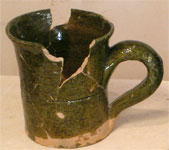
Reconstructing Monasticism
Daily Life
Evidence for daily monastic life survives in archaeological contexts and in the texts associated with the abbey. The most ubiquitous are the ceramic vessels used in cooking, eating, drinking, and storage. Cooking and serving vessels provide a picture of the types of foods (stews and vegetable dishes seem to have been predominant), and demonstrate the ways in which pottery styles changed across time. The monastic table evolved along with monastic diet. Animal bones from sealed deposits also provide precious information about the foods eaten by the monastic community. While much of the archaeological record pertains to diet, exceptional objects point to other aspects of quotidian life. A polished bone “pointer” may have been used to follow lines of text while reading or to open letters.In the textual record, our evidence for daily life comes principally from the customary. This text provides the sequence of the monastic hours, focusing upon the prayers and liturgical offices that shaped the monastic day (see Time). The customary also provides glimpses of more quotidian experience, including information on eating and clothing. Lectio 3, for example, talks not only about the ritual purification at the lavabo, but reminds the brothers not to blow their noses on the hand towels there. Lectio 13 discusses restrictions on nakedness, admonishing brothers not to walk barefoot. Lectio 17 discusses restrictions on pillows (they may not be made of silk) and tells brothers how to make their beds. Lectio 23 (on the Vestarer’s responsibilities) provides a useful description of the monastic habit, and gives a list of the clothing each brother was to receive each year (3 shirts, drawers, a rochet and a hooded cloak, 2 pairs of shoes, an undercoat, overcoat and a fur lining.) Lectio 26 (on the Kitchener) provides wonderful insights into the foods that were eaten (meats, eggs, cheese, chicken, fish and vegetables). Lectio 44, article 4 reminds the brothers that they should avoid games of dice and chess, and should not hunt for sport.





 This web site was supported by a grant from the National Endowment for the Humanities.
This web site was supported by a grant from the National Endowment for the Humanities.